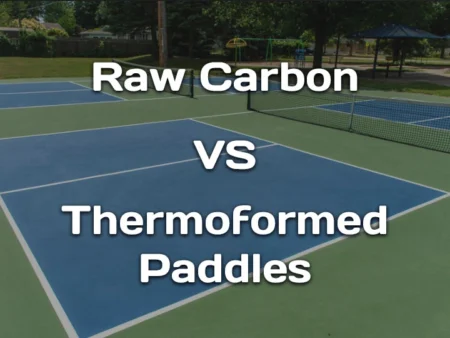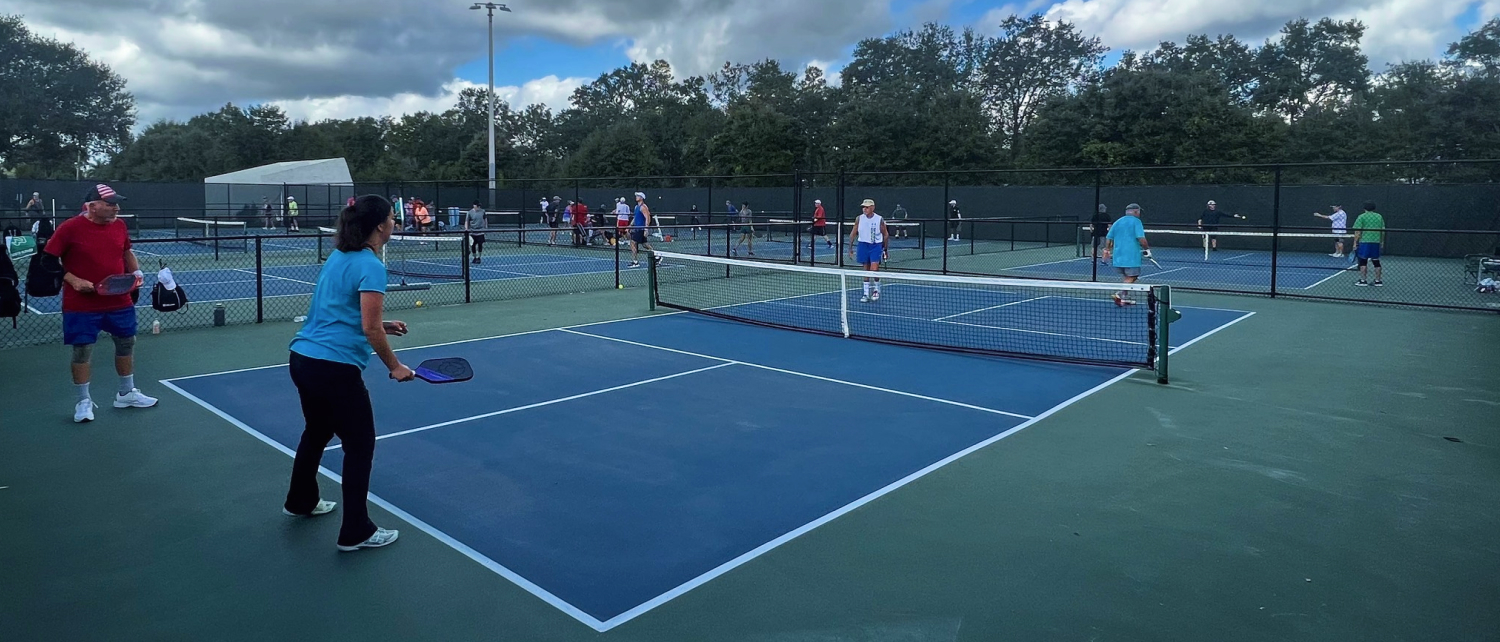Your cart is currently empty!

In the world of pickleball paddles, the materials and technologies used in their construction can significantly affect performance. Two terms you might encounter are “raw carbon” and “thermoformed” paddles. Here’s a breakdown of their differences, benefits, and disadvantages.
Raw Carbon Paddles
Raw Carbon refers to a type of surface material used on pickleball paddles. Contrary to what the name might suggest, it isn’t actually carbon fiber woven together but instead features an embossed texture that mimics the appearance of raw carbon fiber. This surface is designed to increase the spin on the ball by providing a more textured hitting area.
Benefits:
- Exceptional Strength and Durability: Raw carbon paddles are known for their superior strength, which comes without a significant increase in weight. This durability ensures that the paddles can withstand rigorous play over time [2].
- Lightweight Construction: The lightweight nature of raw carbon paddles enhances maneuverability, allowing players to make quick, agile movements. This can be particularly beneficial during rapid exchanges at the net, offering faster hand speed and reaction time [1][4].
- Improved Control: Some raw carbon paddles feature unique grips and surface textures that provide players with enhanced control over the ball. This can lead to more precise shots and better handling during play [6].
- Direct and Crisp Feel: Players might find that raw carbon fiber paddles offer a more direct connection with the ball, delivering a crisp, clean feel upon contact. This can improve a player’s ability to execute accurate and powerful shots [3].
- These benefits make raw carbon fiber paddles a p
Disadvantages:
- Misleading Terminology: The term “raw carbon fiber” can be somewhat misleading. It often refers to an embossed texture rather than actual woven carbon fiber, which could lead to confusion among buyers about the product they are purchasing .
- Feel and Control: Although not explicitly mentioned in the provided sources, players accustomed to different materials may find raw carbon paddles to offer a different feel and control level. Generally, carbon fiber paddles are known for providing a firmer, more crisp feel when striking the ball . This could be a disadvantage for players looking for a softer touch or more cushioned feedback during play.
- Cost: High-quality carbon fiber materials can be expensive due to the production processes involved. This cost can make raw carbon paddles more expensive than their counterparts made from other materials, potentially putting them out of reach for budget-conscious players.
- Durability Concerns: While carbon fiber is renowned for its strength and durability, the specific construction and coating of raw carbon paddles can affect their longevity. Paddles without a protective layer or with a purely “raw” finish may be more susceptible to wear and tear over time.
Thermoformed Paddles
Thermoformed paddles are constructed using a process that molds the paddle under heat to create a stiff and durable structure. This process can involve different materials, including carbon fiber, to enhance the paddle’s performance characteristics.
Benefits:
- Enhanced Durability: Thermoformed paddles undergo a manufacturing process where the material is heated and molded under pressure, creating a robust and durable structure. This process ensures that the paddle withstands the rigors of regular play, offering a longer lifespan compared to some traditional manufacturing methods.
- Improved Surface Texture: Thermoforming allows for the creation of embossed textures on the paddle’s surface, which can enhance spin and control. This textured surface grips the ball better upon contact, allowing players to execute more precise shots with additional spin, thereby improving their game.
- Stiffer Feel for Power Shots: Thermoformed paddles often provide a stiffer feel, which can be advantageous for players looking to generate more power in their shots. The rigid structure of the paddle translates the player’s energy more efficiently into the ball, enabling forceful drives and smashes.
- Aesthetic Flexibility: The thermoforming process offers manufacturers greater flexibility in designing paddles with varied colors, patterns, and aesthetic features. This means players can choose paddles that not only perform well but also reflect their personal style and preferences.
- Innovative Designs: As thermoforming technology advances, manufacturers can experiment with different materials and composite layers, leading to innovative paddle designs. These innovations can result in paddles with optimized weight distribution, improved balance, and enhanced feel, catering to the needs of diverse player segments.
- Consistent Performance: The controlled manufacturing process of thermoforming ensures uniformity in the production of paddles, leading to consistent performance across units. Players can expect the same level of quality and playability from every paddle produced, eliminating variability and ensuring reliability in competitive play.
Disadvantages:
- Stiffness: Thermoformed paddles often have a stiffer feel compared to other materials like carbon fiber. This stiffness can lead to less control over softer shots and can make delicate plays, such as drop shots or dinks, more challenging for some players.
- Cost: The manufacturing process for thermoformed paddles, which involves heating and molding plastics and composites into shape, can be more complex and costly than other types of paddle construction. This can make thermoformed paddles more expensive for consumers.
- Vibration: The stiffer material may not absorb impact as well as softer materials, leading to more vibration transmitted to the player’s hand and arm. This can potentially increase the risk of discomfort or even injuries like tennis elbow over prolonged use.
- Weight: Thermoforming can sometimes result in paddles that are heavier than those made from other materials. While some players may prefer a heavier paddle for power, others may find it cumbersome and fatiguing to use during long matches.
- Customization Limitations: Due to the nature of the thermoforming process, there might be limitations on the degree of customization available for paddle designs. This can affect players who prefer highly personalized equipment tailored to their specific playing style or aesthetic preferences.
- Feel and Sound: The unique construction of thermoformed paddles can alter the feel and sound upon ball impact, which might not be appealing to all players. Some may prefer the traditional feel and acoustic feedback of graphite or carbon fiber paddles.
In summary, raw carbon paddles offer enhanced spin capabilities due to their textured surface, but the terminology can be misleading. Thermoformed paddles, on the other hand, provide a stiffer feel and increased durability but may lack the control some players prefer. Each type of paddle has its unique benefits and potential drawbacks, making it essential for players to choose based on their playing style and preferences.
by



